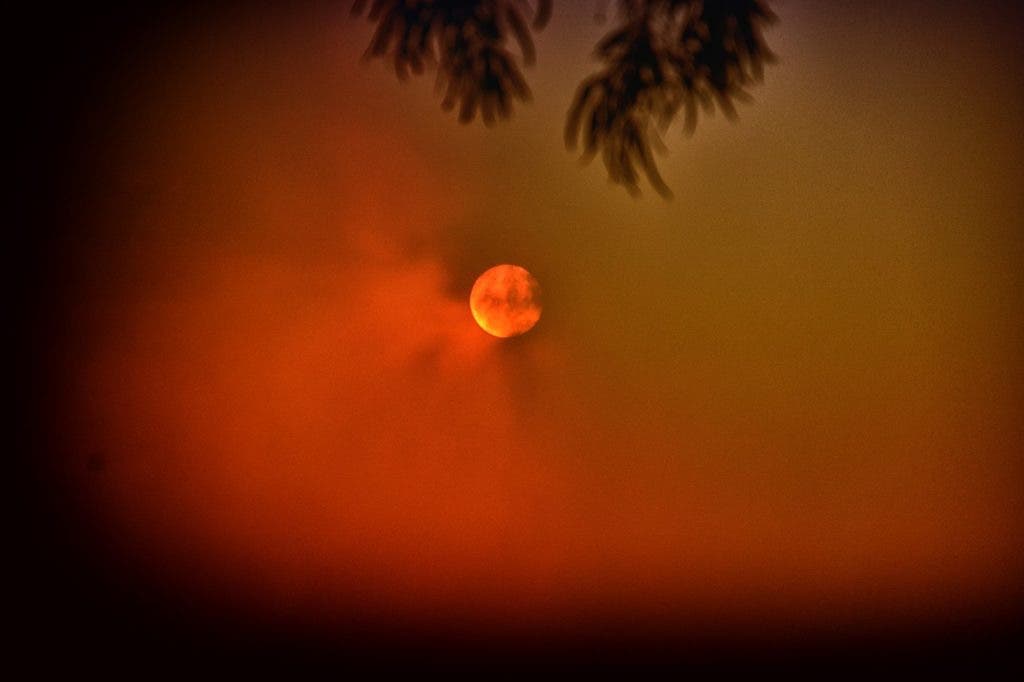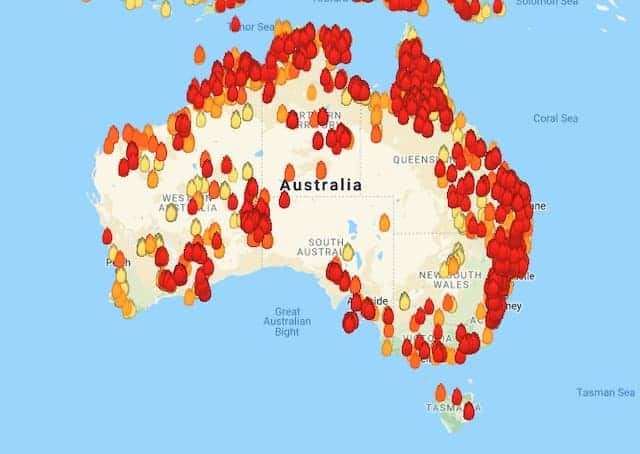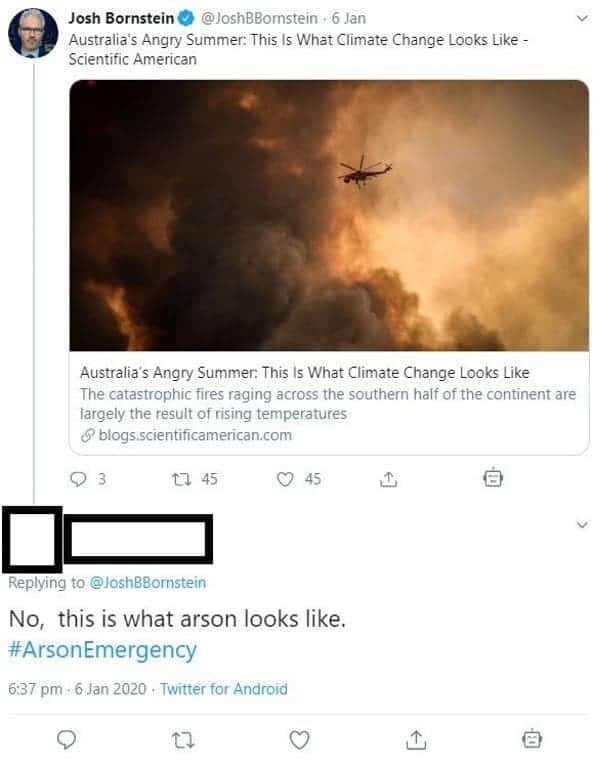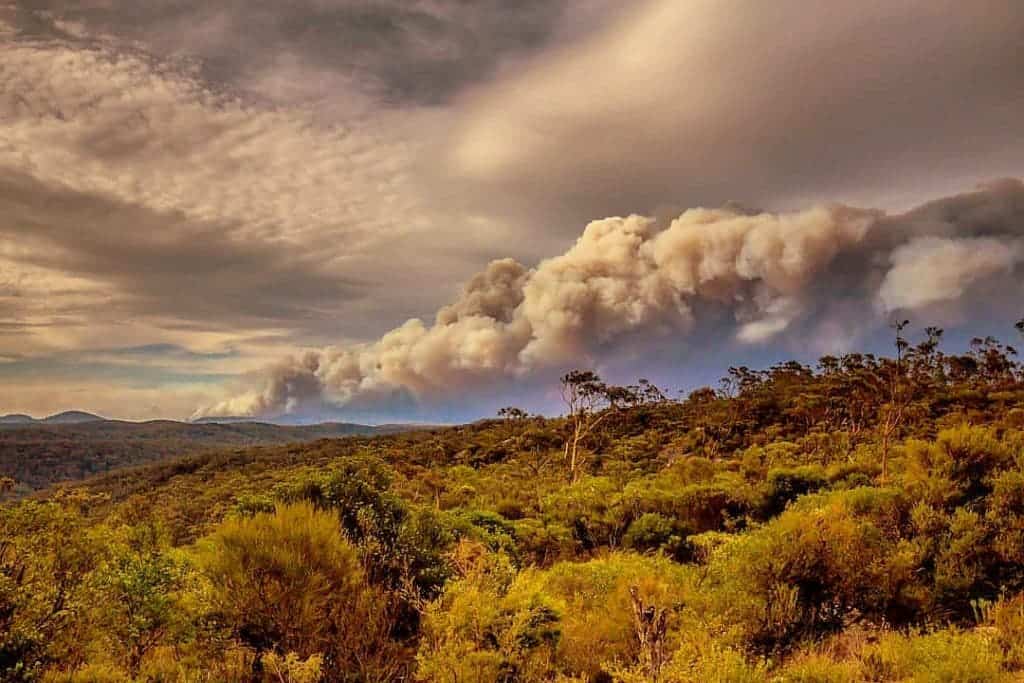The tragic wildfires in Australia have been burning since September, claiming the lives of at least 28 people, displacing thousands, and killing more than a billion animals.
In the wake of this tragedy, few positives will remain. But there are lessons to be learned from this catastrophe, and among these lessons is how climate change deniers try to distort the truth in their favor — something which we can expect to become more common as warming unfolds its effects.
If we want to limit such tragedies in the future and tackle global warming more effectively, we’d best pay attention to their strategies.

Strategy 1: Deny
The era of climate change is unfolding before our eyes. The effects are, while not always traceable to singular events, clearly evident in long-term trends. Australian researchers have predicted, for over a decade, that climate change will exacerbate drought and wildfire (just like it’s been known for a while that climate change also affects things like hurricanes and drought).
Climate change does not ignite fires itself, but it makes it much more likely for fires to happen — and when they do, it also makes them more dangerous. It produces more fuel for the fires (in the form of dried vegetation) and less water because of higher evaporation and drought.
“Climate change is increasing bushfire risk in Australia by lengthening the fire season, decreasing precipitation and increasing temperature,” according to the Australian Bureau of Meteorology.
The view of Australian researchers is not in agreement with the scientific consensus — the evidence is overwhelming in this regard.
“There are many drivers of wildfires, but its increasingly clear that hotter, drier conditions play a big role in making them worse,” said Zeke Hausfather, a climate scientist at Berkeley Earth, a climate research organization, in a tweet.
Not too long ago, climate change deniers would have (as the name sort of implies) just denied this connection. To an extent, this is what is happening now: many politicians in Australia’s ruling party, which has long-reaching ties to the coal industry, are denying these impacts of climate change.
It’s hardly surprising that this is happening. Climate change has become a bit of a tradition in Australian culture, and that won’t change just because wildfire is ravaging the country.

Several prominent Members of Parliament (MP) and the government have expressed their views that climate change is not playing any role. Craig Kelly, a New South Wales MP, one of the areas most affected by the recent fires, recently made the headlines when he called a British meteorologist an “ignorant pommie weather girl” after openly denying the existence of climate change.
“Well firstly there is no link, the facts that cause the fires are the drought and the drying of the environment and on this our climate scientists down here have been very clear and they have said that there is no link between drought and climate change,” Kelly said, blatantly ignoring what scientists are actually saying.
Matt Canavan, a pro-coal Queensland senator has said that nothing Australia can do will lower bushfire risk. George Christensen, a Queensland MP, has been sharing disproven theories that arson is to blame for this tragedy (more on that just a bit later). The list could go on and on.
However, some politicians are starting to pick up on the changing tide, understanding that more and more people are now realizing the impact of climate change and that simply denying things is not very effective.
So instead of outright denying, they’re deflecting or downplaying the connection to climate change.
Strategy 2: Deflect and Downplay
Australian Prime Minister Scott Morrison has done his best to avoid any mention of climate change — going so far as outright avoiding answering questions about it and even ending and ending his own press conference. It’s a strategy that conservative politicians in the US often employ when it comes to taking action on gun violence: they’re quick to send out empathy (“thoughts and prayers”) and say that “now is not a good time for this” — except it’s never a good time.
Morrison has repeatedly sent his thoughts and prayers to firefighters and everyone affected by the tragedy — which is, of course, never a bad thing as the Australian firefighters deserve the utmost praise as they selflessly battle the fires — but neither is this sufficient.
Morrison, who just two months ago was warning against “climate anxiety”, ultimately released a press release, acknowledging but at the same time downplaying the impact of climate change. He said climate change is “one of many factors” at play — which, while technically true, seems like an ornamental concession. He also did not make any effort to contradict the climate change denial taking place in his own party.
When we look at the full context, it becomes clear that Morrison’s strategy is to downplay the effects of climate change.

Deputy Prime Minister Michael McCormack was even more dismissive. McCormack was asked by ABC Radio National about his thoughts about whether there was a link between the bushfires and climate change. This was his answer:
“We’ve had fires in Australia since time began, and what people need now is sympathy, understanding, help and shelter.
“They don’t need the ravings of some pure, enlightened and woke capital-city greenies at this time.”
If denying doesn’t work, deflecting and downplaying seems like the way to go
Strategy 3: Bots and Fake Social Media Campaigns
Another approach that has become apparent in the wake of the Australia fires is using bots to spark fake social media campaigns — similar to how this is used in political campaigns.
The hashtag #ArsonEmergency began trending shortly after the new year. It seemed to make sense. Australia was burning up, wildfires are sometimes placed by arsonists, so the hashtag picked up a lot of steam — both down under and elsewhere in the world.
But when he looked closer, Queensland University of Technology researcher Timothy Graham found that behind this hashtag, there were hundreds of troll and bot social media accounts that tried to shift the narrative about the fires as being the work of dozens of criminals.
The goal was to make it seem like this is the fault of a few arsonists, and not part of a larger environmental problem that includes climate change.
“We studied about 300 Twitter accounts driving the #ArsonEmergency hashtag to identify inauthentic behaviour. We found many accounts using #ArsonEmergency were behaving “suspiciously”, compared to those using #AustraliaFire and #BushfireAustralia,” Graham wrote, referring to two other hashtags commonly used to discuss the fires.
“Accounts peddling #ArsonEmergency carried out activity similar to what we’ve witnessed in past disinformation campaigns, such as the coordinated behaviour of Russian trolls during the 2016 US presidential election.”
The tweets were trying to spur conspiracy theories.

Conservatives around the world picked up on the discussion, with President Trump’s son, Donald Trump Jr., notably participating and retweeting.
While some bushfires are caused by arson, and this has been historically a problem in Australia, there is no evidence to suggest that the current season was heavily impacted by arson.

Australia’s fires are spreading so far and ferociously due to drought and warm weather — not arson. If anything, arson fires rarely spread beyond five hectares (12 acres), according to the Australian Institute of Criminology.
It’s unclear who was behind this fake social media campaign, but it’s clear that the goal was to change the narrative. This type of approach will almost certainly become commonplace, without stricter policies for social media platforms.
Strategy 4: Manipulating Media
Another part of the conspiracy theory mentioned above was that “greenies” (how some Australians like to call environmentalists) oppose measures to prevent fires. That part is simply false and can be easily disproven — just ask any “greeny”, or check the Green Party’s homepage.
But this allegation was promoted for months by conservative Australian media outlets, especially the ones owned by Rupert Murdoch.
Rupert Murdoch owns an impressive cohort of outlets and has been repeatedly shown to use these outlets to promote conservative views. Of course, there is nothing wrong with owning a large number of outlets and using them to promote your views (well, maybe there is, but this is not the place to discuss this). Some of Murdoch’s outlets, however, are no stranger to the climate conversation — and they promote denialist, misleading, and sometimes conspiracy-ridden views.
A recent editorial highlighted some of these articles: from insulting climate opponents and even victims of the fires to blaming environmentalists for not wanting to take measures against fires — which, again, is an outright falsehood. Murdoch’s national newspaper, The Australian, has also repeatedly argued that this year’s fires are no worse than those of the past — which, yet again, is far from the truth. This season’s bushfires have burned more than the past 15 years combined.
Australia’s ABC reports even more extreme manipulation: “Some of the misinformation includes the idea left-wing ‘eco-terrorists’ are behind some fires.” Rupert Murdoch is influencing Australia’s bushfire debate, steering it away from climate change, and away from the truth.
But this doesn’t mean that everyone falls in line.
“I find it unconscionable to continue working for this company, knowing I am contributing to the spread of climate change denial and lies,” Emily Townsend, a commercial finance manager at News Corp, wrote in an all-staff email that was leaked to the media. She added that the newspapers’ angles of coverage were “not only irresponsible, but dangerous and damaging to our communities and beautiful planet.” Townsend ended up leaving the company.
It’s always difficult to know which media to trust, and even large, established media can cause disinformation.
Picking outlets that don’t have a political agenda is a good place to start, but that’s easier said than done — particularly as some would have climate change itself be a political issue.
Strategy 5: Make it political

Climate change is, above all, a physical phenomenon. As we release more and more greenhouse gases into our planet’s atmosphere, more heat gets trapped, and this raises global temperatures. This is a proven concept, it’s not present only on Earth, and it’s entirely scientific.
The climate emergency — the crisis, or however you may call it — that is political. It involves our response, adaptation, and mitigation of the phenomenon that is climate change.
The distinction might seem small but is very important.
Prominent Australian politicians refused to talk about climate change, labeling it as a political topic. It is not. The connection between climate change and bushfires is not political, it’s a demonstrated fact. You can avoid talking about what measures you will take, that’s a political topic — but the two are distinct, and muzzling the difference between them only works to create more confusion and skepticism about climate change.
The other reason why this distinction is significant is that it tends to make climate action equal to political action. Politics is often an ‘us versus them’ kind of affair, but climate change affects us all equally, regardless of our political color. This is a sneaky tool that has been in the arsenal of some politicians in the US for a while, but attempting to color climate change as a political ploy is a distraction strategy, and one
Strategy 6: Not taking responsibility
It is perhaps unfair to call Australia’s woes a ‘climate suicide’, but it is not a baseless assertion. Australia is the world’s third-largest exporter of CO2 in fossil fuels and the world’s largest coal exporter. Coal is mined in every Australian state, and the country has recently approved the development of a new coal mega-mine. Australia’s current administration has also advertised coal as a solution at climate talks and has lobbied against ambitious climate action.
Australia has a relatively low population of around 25 million people, but it emits more than CO2 other much larger countries. For instance, it emits more than the UK, a highly developed country with a population of some 80 million people. It emits more than Italy, France, and only slightly less than Brazil and Indonesia, countries with over 200 million people. Per capita, Australia’s emissions are only surpassed by “oil states” such as Kuwait, Qatar, and Saudi Arabia.
It’s safe to say that at a global level, Australia isn’t making a major impact. It accounts for only 1.1% of the global emissions. But it’s also safe to say that Australia is having a disproportionate impact on emissions, as it only accounts for 0.3% of the world’s population — and this disproportionate impact cannot be explained by Australia’s geography alone. If the entire world would produce emissions at the same rate as Australia, we would suffer an environmental catastrophe.
So it is true that, technically, Australia can make a low impact at the global stage — directly. But on an international stage, Australia has opposed unified climate action, and while it has taken some action to reduce its emission, the government’s unwavering support of coal overweighs positive action.
It’s a classic Tragedy of the Commons: all individual countries have an incentive to follow their interest, which sometimes means emitting as much as possible pursuing economic growth. But if everyone chases their individual goal, we all collectively suffer for it. If Australia wants to suffer less from the effects of climate change, the best it can do is reduce its own impact and then push others on an international stage to do the same.
Instead, deniers are trying to say that everything Australia can hope to do will not make an impact, so why even struggle. This fatalistic approach will get us nowhere.
As climate change continues to unfold, deniers aren’t standing still. They’re adapting and diversifying their strategies, tailoring them to the current context, and often making them more subtle. They often sprinkle real facts as an attempt to lend credibility to their narrative, shifting the talk away from climate and onto the political field. These efforts will include social media manipulation, sometimes using fake accounts and trolls.
The world should be prepared for these attempts, and the first step of preparation is awareness.






